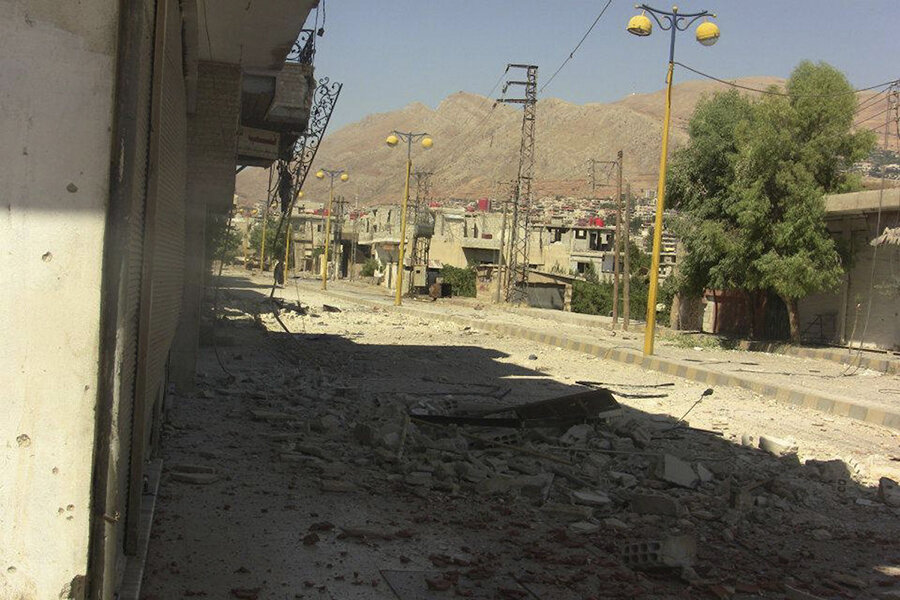In Syria border town, battle intensifies after mistrust sinks cease-fire
Loading...
| Beirut, Lebanon
A cease-fire agreement two weeks ago in the Syrian border town of Zabadani was meant to allow for a relatively peaceful transfer of populations out of multiple war zones, a step toward a smaller but more defendable Syrian state.
But the truce in the former summer resort town 18 miles from Damascus quickly broke down, an indication of the deep animosity and mistrust that characterize the largely sectarian Syrian conflict. The fighting has now resumed in earnest.
The battle has been especially costly for Hezbollah, the Lebanese Shiite militia supporting the embattled Syrian president, Bashar al-Assad. Nevertheless, the Iranian-backed militia reportedly has rejected appeals from Zabadani’s rebel defenders for renewed cease-fire negotiations.
More than 30 Hezbollah fighters are estimated to have been killed fighting well-dug-in rebels in Zabadani, five miles from the border with Lebanon, since the operation to recapture the town began in early July, according to diplomatic sources. In the past week alone, eight Hezbollah fighters were killed, Lebanon’s Al-Manar television reported.
In an interview with Hezbollah’s Al-Manar television broadcast Tuesday evening, Mr. Assad offered glowing praise to his Russian, Iranian, and Hezbollah allies, saying Hezbollah’s presence in Syria was “legitimate,” unlike the armed opposition to his rule, whom he described as “terrorists.”
He also expressed confidence that Moscow and Tehran would continue to stand by Damascus.
Hezbollah fighters began deploying covertly into Syria in 2012, and their presence was only confirmed by the party’s leader, Sheikh Hassan Nasrallah, in May 2013 during a bloody 17-day assault by the Shiite organization on the rebel-held town of Qusayr, five miles north of Lebanon’s border.
Since then, Hezbollah combatants have fought in multiple theaters from Aleppo in the north to Deraa in the south, in many cases supplanting the exhausted and depleted Syrian army in spearheading offensives against the rebels.
Iran sought population transfers
But Assad has lost another 18 percent of the Syria’s territory to rebel forces and the extremist Islamic State group since January, reducing the regime’s hold to a mere sixth of the country, according to an analysis by the UK-based IHS-Jane’s Conflict Monitor.
The territorial retreats and daily casualties that continue to sap the strength of the loyalist forces have encouraged Iran to seek cease-fire deals with Syrian militant groups. Two weeks ago, a tenuous cease-fire was arranged with the militant Islamist Ahrar ash-Sham faction. Hezbollah’s assault on Zabadani was suspended in exchange for a cessation of rebel attacks on two surrounded Shiite villages, Fouaa and Kefraya, in the northern Idlib province and the provision of humanitarian supplies to the stricken areas.
The broader deal Iran sought was to transfer the Sunni population of Zabadani to rebel-held areas in exchange for the removal of Shiites of Fouaa and Kefraya from their homes to settle into regime-controlled areas around Damascus. For Iran and the Assad regime, such an arrangement would strengthen the Damascus government’s control over the key terrain linking the Syrian capital with the Mediterranean coast, the heartland of the Alawite community, a Shiite splinter sect to which Assad belongs.
Hezbollah advancing slowly
But the cease-fire broke down after three days, reportedly when Ahrar ash-Sham and other factions rejected the sectarian population transfers and the Syrian regime refused a rebel demand for the release of 40,000 detainees.
In Zabadani, Hezbollah is making slow progress. Although the town has been battered with barrel bombs, rocket strikes, and artillery shelling, the rebel forces have constructed bunkers and deep underground tunnels that provide protection and allow for movement in relative safety. Booby-traps and snipers also bedevil Hezbollah’s advance deeper into Zabadani.
Nevertheless, Hezbollah and its Iranian backers have reportedly rejected cease-fire appeals, suggesting that the Lebanese group intends to press ahead with its assault until the town is captured.







